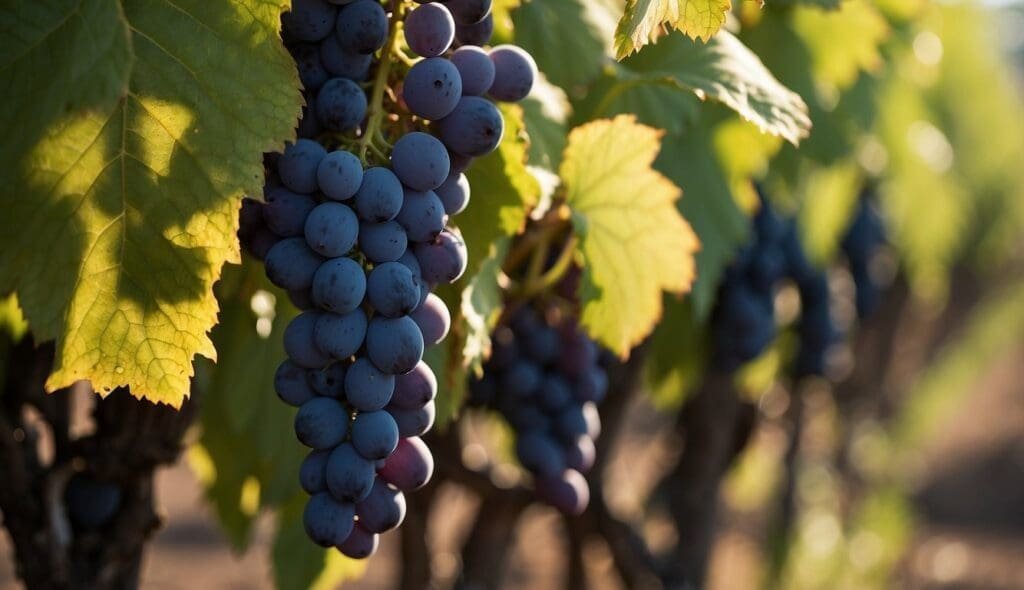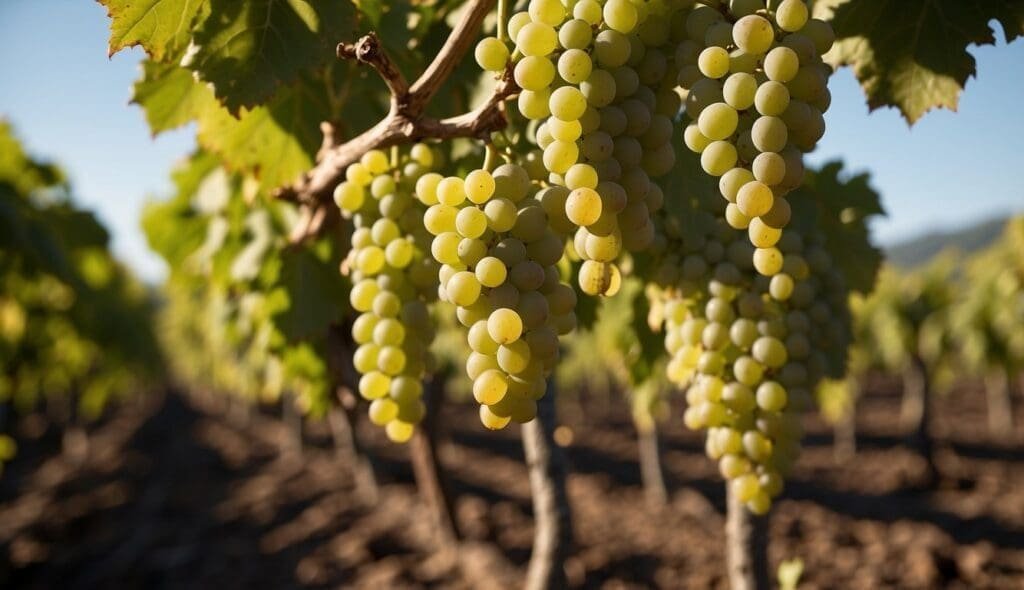This post may contain affiliate links. Please read my disclosure policy.
Have you ever wondered what is a balanced wine? It’s more than just a fancy term wine critics throw around. A balanced wine has all its parts working together in perfect harmony. When you sip a balanced wine, no single element overpowers the others, creating a smooth and enjoyable experience.

Think of balance in wine like a well-tuned orchestra. The five major components – acid, alcohol, sugar, tannin, and water – play their parts without drowning each other out. You’ll notice how a balanced Shiraz from the Barossa Valley feels just right on your palate, with its rich fruit flavours complemented by a touch of acidity and smooth tannins.
Achieving balance is key to making quality wine. When you taste a balanced Margaret River Chardonnay, you’ll appreciate how the crisp acidity balances the full-bodied fruit flavours. This harmony makes balanced wines more pleasant to drink and often more food-friendly.
Defining Balance in Wine
A balanced wine has its components working together harmoniously. This harmony creates a pleasant sensory experience and showcases the wine’s best qualities.
Elements of Balance
Wine balance involves several key elements. Acid, alcohol, sugar, tannin, and fruit all play crucial roles. Acid gives wine its zesty freshness. Tannins provide structure and a dry mouthfeel, especially in reds like Shiraz.
Alcohol adds body and warmth. Sugar affects sweetness levels. Fruit flavours round out the wine’s profile. Each element must be in proper proportion to the others.
Too much of one component can throw a wine off balance. For example, overly acidic wines may taste sharp. Wines with high alcohol but low fruit can feel “hot” on the palate.
Sensory Experience
Balance in wine is all about how it feels in your mouth. A well-balanced wine should have a smooth, harmonious texture. No single element should overpower the others.
When you taste a balanced wine, you’ll notice how the flavours and sensations flow together. The initial fruit flavours should transition smoothly into the finish. A balanced Chardonnay, for instance, might have just enough oak to complement its fruit without overwhelming it.
The wine’s sweetness, acidity, and tannins should work together to create a pleasing overall impression. This balance allows you to appreciate the wine’s complexity and nuances.
Factors Influencing Balance

Wine balance depends on several key elements. These include the winemaking process, grape maturity at harvest, and the use of oak during ageing.
Winemaking Techniques
Winemakers play a crucial role in creating balanced wines. They control fermentation, which affects alcohol levels and sweetness. You’ll find that longer fermentation times lead to drier wines with higher alcohol content.
Maceration, where grape skins soak in the juice, impacts tannin levels. This process is especially important for red wines. Longer maceration times increase tannin extraction, adding structure to the wine.
Balancing wine components also involves managing acidity. Winemakers might adjust acid levels to achieve the right balance. They can do this by blending different grape varieties or using techniques like malolactic fermentation.
Grape Ripening and Harvest
Grape ripeness at harvest greatly affects wine balance. As grapes ripen, sugar levels increase while acidity decreases. This balance is crucial for the final wine.
Harvesting too early can lead to wines with high acidity and green flavours. Picking too late might result in wines with high alcohol and low acidity. The goal is to find the sweet spot.
Climate plays a big role in ripening. Warmer regions like the Barossa Valley often produce fuller-bodied Shiraz. Cooler areas like Tasmania are known for crisp Chardonnays with higher acidity.
The Role of Oak
Oak barrels can significantly impact wine balance. They add flavours like vanilla and spice, which need to blend well with the wine’s fruit character.
New oak imparts stronger flavours, while older barrels have a subtler effect. The time spent in oak also matters. Too much oak can overpower the wine’s natural flavours.
Different oak types affect the wine differently. French oak tends to give more subtle flavours, while American oak often adds bolder notes. Aussie winemakers might use a mix to achieve the right balance.
Assessing and Tasting Balanced Wine

Tasting a balanced wine involves using your senses to spot key traits. You’ll learn to spot flavours and judge how well they work together.
The Tasting Process
Start by looking at the wine’s colour and clarity. Swirl it gently to release its scents. Take a small sip and let it coat your mouth. Pay attention to how the wine’s components fit together. A balanced wine should have no single element that stands out too much.
Notice how long the flavours last after you swallow. This is called the finish. A good finish is often a sign of a balanced wine.
Try comparing different wines side by side. This can help you spot the differences in balance more easily. For example, taste a Barossa Shiraz next to a Hunter Valley Semillon.
Common Descriptors
When describing a balanced wine, you might use words like “harmonious” or “integrated”. These mean the wine’s parts work well together. Other terms include “smooth”, “well-rounded”, or “cohesive”.
For red wines like Coonawarra Cabernet Sauvignon, you might say the tannins are “soft” or “silky”. This means they don’t overpower the other flavours.
White wines like Margaret River Chardonnay might be described as having “crisp acidity” that matches its fruit flavours. A dessert wine like Rutherglen Muscat should have sweetness balanced by acidity.
Remember, balance doesn’t mean bland. A balanced wine can still be bold and flavourful. It just means no single part sticks out too much.
Influence of Climate and Region

Climate and region play crucial roles in shaping a wine’s balance. They affect grape ripeness, sugar levels, and acidity, which are key to creating a well-balanced wine.
Varietal Characteristics
The climate where grapes grow impacts their flavour and structure. In cooler regions like Tasmania, you’ll find crisp Rieslings with high acidity and lower alcohol. These wines often have a lively balance between sweetness and tartness.
Warmer areas such as the Barossa Valley produce fuller-bodied Shiraz with riper fruit flavours and higher alcohol content. The heat helps develop rich tannins, creating a different kind of balance.
Climate change is affecting wine regions across Australia. As temperatures rise, some cool-climate varietals may struggle. Winemakers are adapting by planting heat-tolerant varieties and adjusting vineyard management.
You’ll notice regional differences in the same grape variety. A Chardonnay from cool Margaret River will be leaner and more acidic than one from warmer Hunter Valley. This showcases how climate influences a wine’s balance.
Frequently Asked Questions
Wine balance involves several key factors that work together harmoniously. Understanding these elements helps wine enthusiasts appreciate and identify well-balanced wines.
What distinguishes a wine as being fully balanced?
A fully balanced wine has all its components in the right proportions. You’ll notice that no single element overpowers the others. The flavours, aromas, and textures blend smoothly, creating a pleasant drinking experience.
What characteristics define the balance in a wine?
Five main components contribute to wine balance: acid, alcohol, sweetness, tannin, and concentration. When these elements are in the right ratio, you’ll enjoy a well-rounded wine. A balanced Shiraz, for example, will have just the right amount of fruit, tannins, and alcohol.
How can one tell if a wine is unbalanced?
You can spot an unbalanced wine when one element stands out too much. If a Chardonnay tastes overly acidic or a Cabernet Sauvignon feels too alcoholic, it’s likely unbalanced. Trust your palate – if something seems off, the wine might lack balance.
What are some examples of food pairings that complement a balanced wine?
Balanced wines pair well with a variety of foods. A well-balanced Semillon can complement grilled fish or roasted chicken. For red wines, a balanced Grenache pairs nicely with barbecued meats or hearty stews.
In what ways do tannins contribute to the balance of a wine?
Tannins add structure and texture to wine. In a balanced red wine like Shiraz, tannins provide a pleasant astringency without being too harsh. They work with other elements to create a full-bodied experience.
Can fortified wines be considered balanced and what are their characteristics?
Fortified wines can indeed be balanced. A well-made Australian Muscat balances sweetness with alcohol and acidity. You’ll find complex flavours and a smooth finish in balanced fortified wines.
User Review
( votes)Sip smarter, subscribe now!
Subscribe for gourmet tips, event updates, travel ideas, and a free e-book on Food Pairings. Start your journey to culinary and travel excellence!












